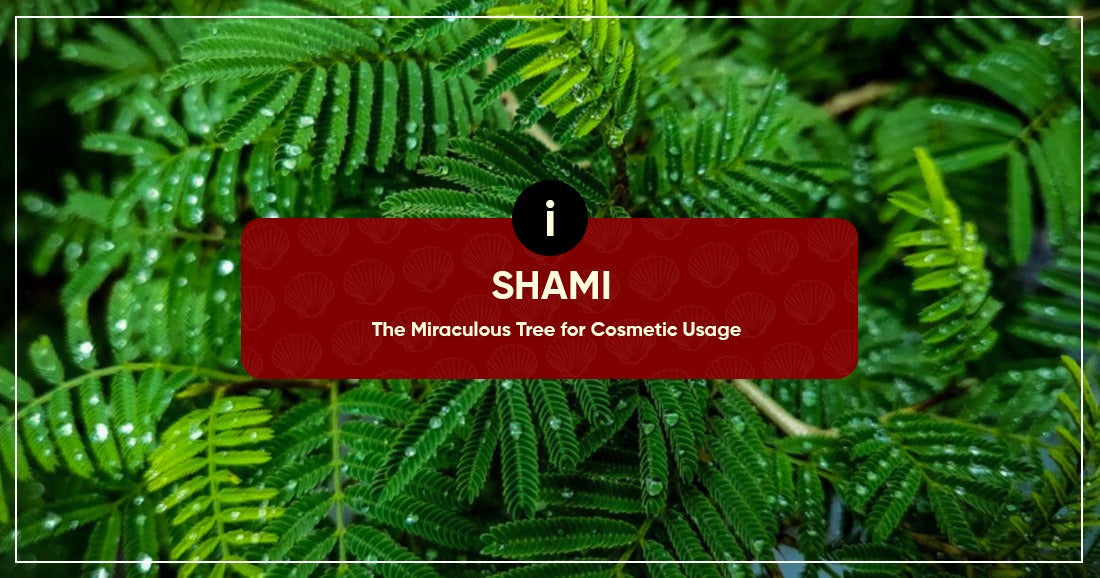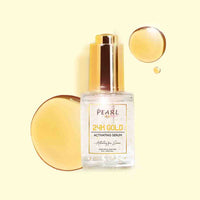Shami The Miraculous Tree for Cosmetic Usage The significance of Shami is increasing in the world of cosmetics. Its scientific name is Prosopis cineraria and belongs to the family of Fabaceae. It grows in Sandy, loamy type of soil and mildly acidic in nature and can be seen mostly in Southern Asia. It is called Shami in Madhya Pradesh, Maharastra & Uttar Pradesh, Jammi in Telangana & Andhra Pradesh, Khijro in Gujarat, Khejri in Rajasthan, Janti in Haryana, and Jand in the Punjab. It is non-toxic in nature and needs full sun exposure. Its leaves are bipinnate, meaning they have a feather look. It is a medium sized tree with whitish branches with very tiny leaves all over. It can withstand drought conditions.
With its numerous advantages and properties, it is used in different therapeutic treatments in Ayurveda as well because of its anti-inflammatory effects. Let us delve deep into the usage of Shami in cosmetics.
Religious Significance Of Shami
According to Hindu mythology, it is very auspicious to have a Shami plant inside the house and is being worshipped. According to Hindu Puranas, it is believed that people who plant Shami at home and offer prayers do not face any shortage of money. This tree is worshipped on the tenth day of Dusshera festival, the day after the Navaratri in various regions of India.
In Mahabharata before the Pandavas entered Virata kingdom, they hid all their celestial weapons in this tree for a year. After a year at Virata Kingdom, they found all the weapons safe under the tree, so they thanked it for keeping their weapons safe.
Benefits of Shami
Shami is believed to be as beneficial as Tulasi plant. All parts of the Shami like fruits, leaves, roots have enormous benefits for anti-aging, improve digestion and heart health.
Skin Healing and Repair
Shami's anti-inflammatory and antimicrobial properties make it an excellent ingredient for skincare products. It heals and repairs the skin. It helps to treat acne, eczema, and other inflammatory skin conditions. Its natural compounds help reduce redness, swelling, and prevent infections.
Anti-aging Benefits
The antioxidants present in Shami help to fight the free radicals, that are responsible for premature aging. By integrating Shami extracts into anti-aging creams and serums will reduce the appearance of fine lines, wrinkles, and age spots and thus promotes youthful and radiant skin.

Moisturization and Hydration
As Shami extract is well known for its hydrating properties, it is used in lotions and moisturizers. It helps maintain the skin's moisture and prevents dryness and flakiness. Shami is an ideal ingredient for products designed for dry and sensitive skin.
Hair Care
Shami is also known to have positive effects on hair health. Its ingredients help to strengthen hair follicles, decrease hair fall, and encourage healthy hair growth when added to shampoos and conditioners. Because of its anti-inflammatory qualities, the scalp is less itchy and less prone to dandruff.
Natural Sunscreen
Shami may also be used as a natural sunscreen ingredient. Its extracts are useful addition to sunscreen compositions because they can act as a barrier against damaging UV rays. The chance of long-term solar damage is decreased, and sunburn is helped by this natural defense.
How to use Shami in your Daily Skincare Routine
It is very easy to incorporate Shami into our everyday skincare routine. It has a lot of potential advantages. First, make a paste by combining water and Shami powder. After applying this paste to the face, body, or skin, gently massage it in a circular manner. Then, rinse it off with warm water. By cleaning and exfoliating the skin, this procedure encourages blood flow. Shami can be mixed with other natural products for even greater benefits. Turmeric's skin-brightening qualities, for example, it can help lighten pigmentation and dark spots when combined with Shami.
Combining Shami with neem powder, strengthens its antibacterial properties and is particularly helpful for skin prone to acne. It is another powerful combo. Just make a paste by mixing equal amounts Shami and neem powder with water and apply it to the face and let it settle for fifteen to twenty minutes. After that wash it off with warm water. This mixture helps to keep breakouts at bay while also purifying the skin. Furthermore, distilled water can be used to boil Shami leaves to make a moisturizing toner that calms and revives the skin. Skin that is healthier, brighter, and more vibrant can be achieved by including these easy Shami-based remedies into our daily routine.
Conclusion
The Shami tree is a living example of nature's amazing capacity to supply remedies for both health and beauty, thanks to its wealth of medicinal and cosmetic uses. Because of its anti-inflammatory, antibacterial, and antioxidant qualities, it is a useful component of both contemporary cosmetic formulas and traditional herbal therapy. We may continue to learn about and take advantage of the natural advantages that Shami provides by using its power, ensuring a comprehensive approach to skincare and wellbeing. The use of Shami in herbal and cosmetic applications is anticipated to grow as research continues, offering even more benefits to customers looking for safe and efficient natural solutions.










